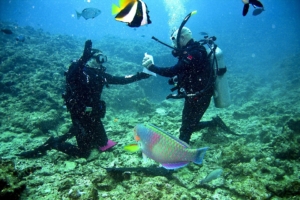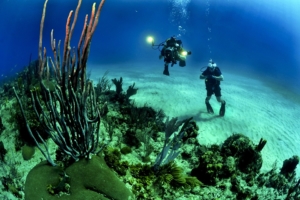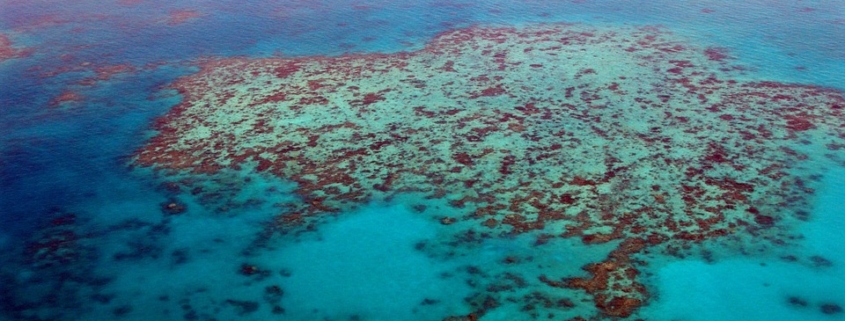While covering less than 1% of the ocean floor, coral reefs are among the most diverse ecosystems in the world. Approximately one-quarter of all marine species like in or around coral reefs, including fish, algae, shrimp, mollusks, sponges, clams, crabs, worms and more. As a result, coral reefs have become popular dive sites. With their unparalleled level of biodiversity, you’ll encounter countless forms of marine life when diving around a coral reef. Whether you’re planning a dive trip to the Great Barrier Reef, the Amazon Reef, the Tubbataha Reef or any other coral reef, though, you should follow these 10 rules.
#1) Look But Don’t Touch
The golden rule of diving around a coral reef is to look but don’t touch. You can marvel at these intricate underwater structures — and you can take photos or record videos of them — but you should never touch them. Certain species of corals are razor sharp, and touching them could result in serious bodily injury. Furthermore, corals have a delicate, living membrane covering their calcified skeleton. If you touch this membrane — with any part of your body or an object — you may inadvertently pierce it, leaving the coral susceptible to infection.
#2) Inquire About Dive Group Size
Before diving around a coral reef, contact either a private or municipal tourism organization to find out how large your dive group should be. Why does this matter? Large dive groups are more likely to damage or disturb corals and their respective marine life than smaller dive groups. The Australian government’s Great Barrier Reef Marine Park Authority recommends diving in groups of no more than six people. Other government-run marine departments may recommend even smaller dive groups for their coral reefs. By following the recommendations for your coral reef dive site, you’ll reduce your group’s environmental footprint.
#3) Stay Off the Bottom
 While most divers know not to touch corals, many assume that it’s okay to walk on the ocean floor if there are no corals growing on it. The problem with walking on the ocean floor around corals, however, is that it stirs up sediment, which eventually lands on corals. Corals are porous, consisting of a honeycomb-pattern of small holes in which algae lives. If you walk along the bottom of the ocean floor next to a coral, some of the sand and sediment will coat the coral and clog its pores. When this happens, algae won’t be able to make its way inside the coral. And because algae is the main source of food (energy) for corals, this often leads to bleaching and eventually the death of corals.
While most divers know not to touch corals, many assume that it’s okay to walk on the ocean floor if there are no corals growing on it. The problem with walking on the ocean floor around corals, however, is that it stirs up sediment, which eventually lands on corals. Corals are porous, consisting of a honeycomb-pattern of small holes in which algae lives. If you walk along the bottom of the ocean floor next to a coral, some of the sand and sediment will coat the coral and clog its pores. When this happens, algae won’t be able to make its way inside the coral. And because algae is the main source of food (energy) for corals, this often leads to bleaching and eventually the death of corals.
If you find yourself sinking to the bottom, consider using a buoyancy compensator. Also known as a buoyancy control device (BCD), this inflatable vest will provide you with greater buoyancy control while underwater. Using the BCD’s control mechanic, you can increase or decrease the amount of air in it. With our air, the BCD will make you more buoyant. With less air, it will make less buoyant.
#4) Don’t Feed the Fish
You’ll probably encounter dozens of fish species when diving around a coral reef. Regardless of which species you encounter, though, you shouldn’t feed them. Lots of fish live around coral reefs because they eat the plants and algae growing on corals. If you feed the native fish — and other divers follow suit by feeding them as well — they may stop feasting on the corals’ plants and algae. Over time, the plants and algae grow out of control, taking over the coral and disturbing its natural ecosystem.
#5) Secure Your Equipment
Double check your equipment before diving around a coral reef to ensure that it’s not loose. If you’re using a weight belt, for example, make sure the individual weights are secured to the belt. If a weight is loose, it could fall onto a piece of coral. Of course, you should secure all your diving equipment. Anything that falls onto or even brushes against a coral may cause serious damage to it.
#6) Keep a Safe Distance From Marine Life
Always keep a safe distance from marine life when diving around a coral reef. As with corals, you shouldn’t touch any marine life that you encounter during your dive. Some seemingly harmless species of fish are actually venomous, and touching them could result in debilitating pain or even paralysis. Even if a fish isn’t venomous, touching it may harm the mucus membrane covering its scales. Whether it’s a fish, crab, lobster or any form of marine life, keep your distance to avoid disturbing it.
#7) Wear Gloves
Some divers believe it’s best to leave their gloves on the boat when diving around a coral reef, as brushing against a coral with gloves could damage it. This isn’t technically wrong. Touching a coral with either your bare hand or a gloved a hand may damage it. Nonetheless, you should still wear gloves when diving around a coral reef to protect your hands from injury. Hopefully your hands never touch the coral, but if you accidentally brush a hand against it, wearing gloves could prevent serious cuts or burns.
#8) Research the Marine Life Before Diving
 Assuming this is your first time diving around a particular coral reef, you should spend some time researching the local marine life. No two coral reef systems have the exact same species of marine life. If it’s your first time diving at a coral reef, you’ll encounter a myriad of unfamiliar marine species. By researching the coral reef’s marine life, though, you’ll a better idea of what to expect.
Assuming this is your first time diving around a particular coral reef, you should spend some time researching the local marine life. No two coral reef systems have the exact same species of marine life. If it’s your first time diving at a coral reef, you’ll encounter a myriad of unfamiliar marine species. By researching the coral reef’s marine life, though, you’ll a better idea of what to expect.
#9) Choose a Reputable Dive Charter
You shouldn’t choose just any dive charter to take you out to a coral reef. Many fly-by-night dive charters are careless with their operations. Some, for example, may drop anchor without first checking to see if there’s coral underneath. And if the boat drops anchor directly over a coral, it will crush and destroy the underlying coral.
How do you know if a dive charter is reputable? You can always ask the locals for recommendations, although another way to verify the reputation of a dive charter is to look on TripAdvisor. Using the online review website, you can read firsthand experiences from the charter’s past customers. If there’s a high ratio of positive-to-negative reviews, you can rest assured knowing the dive charter is a reputable and credible business. If the ratio is reversed, you may want to book your dive elsewhere.
#10) Use Mineral-Based Sunscreen Lotion
Choose a mineral-based sunscreen lotion to wear when diving around a coral reef. In 2019, Hawaii became the first state to ban sunscreen lotions containing either oxybenzone or oxctinoxate. While these two chemicals have been uses in sunscreen lotions for decades, new studies have linked them to coral bleaching, which is the basis for Hawaii’s recent ban of sunscreen lotions containing oxybenzone or oxctinoxate. Beginning 2021, Hawaii businesses won’t be allowed to sell sunscreen creams, lotions, sprays or other products if they contain one of these ingredients.
If you’re going to wear sunscreen lotion during your dive trip, choose a lotion containing a mineral-based UV-filtering ingredient like zinc oxide. They are just as effective at protecting against sunburn and related UV-related skin damage, but they won’t induce bleaching in coral reefs.
Want to create your own custom dive logs? Contact us today to learn more about our custom dive logs.



